Morenada
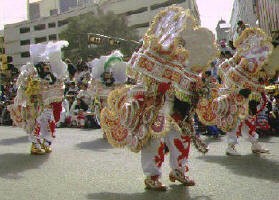 Morenada dance is inspired by Spanish colonization
of XVIth century which had massively imported African black slaves (mainly from Guinea) to work in the mines of Potosi. The
Dance presents in a satirical way the difficult working conditions of the minors, and the melancholic music testifies of their
pains and sufferings. Chained slaves, stiff by the cold winds of the Altiplano, and fainting under the heavy loads to carry,
all these working conditions are transcribed in the steps of the morenos dancers and their imposing costumes (of more than
15 kilos!). On top of their black mask decorated with long feathers, a white wig symbolizes the snow that the African slaves
discovered with stupor when they arrived in Bolivia.
Morenada dance is inspired by Spanish colonization
of XVIth century which had massively imported African black slaves (mainly from Guinea) to work in the mines of Potosi. The
Dance presents in a satirical way the difficult working conditions of the minors, and the melancholic music testifies of their
pains and sufferings. Chained slaves, stiff by the cold winds of the Altiplano, and fainting under the heavy loads to carry,
all these working conditions are transcribed in the steps of the morenos dancers and their imposing costumes (of more than
15 kilos!). On top of their black mask decorated with long feathers, a white wig symbolizes the snow that the African slaves
discovered with stupor when they arrived in Bolivia.
Diablada
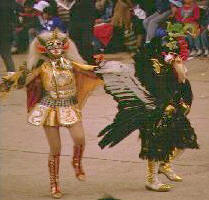 Diablada dance was born in the mining city of Oruro during the XVII-XVII-XVIIIth
centuries, testifying the religious homage of Spaniards to miraculous Virgen of Candelaria (Virgin of the Candlemas) whose
painting was discovered in the shelter of the famous thief Nina Nina, and was considered as the protective mother of the miners.
This spectacular dance puts in scene various characters symbolizing the fight betwen the good against the bad:
devils with masks and wearing colorful golden clothes, their leader
Lucifer (master of the demons) which incarnates the 7 capital sins and the she-devil of the hills
China Supay. Opposed to the devils, the Archangel San Miguel with 7
virtues leads the dance after having defied and triumphed over Lucifer. Two animal figures, the bear
and the condor also take part in the dance. Diablada is the symbol of the carnival of Oruro.
Diablada dance was born in the mining city of Oruro during the XVII-XVII-XVIIIth
centuries, testifying the religious homage of Spaniards to miraculous Virgen of Candelaria (Virgin of the Candlemas) whose
painting was discovered in the shelter of the famous thief Nina Nina, and was considered as the protective mother of the miners.
This spectacular dance puts in scene various characters symbolizing the fight betwen the good against the bad:
devils with masks and wearing colorful golden clothes, their leader
Lucifer (master of the demons) which incarnates the 7 capital sins and the she-devil of the hills
China Supay. Opposed to the devils, the Archangel San Miguel with 7
virtues leads the dance after having defied and triumphed over Lucifer. Two animal figures, the bear
and the condor also take part in the dance. Diablada is the symbol of the carnival of Oruro.
Saya (Caporales de la Tuntuna)
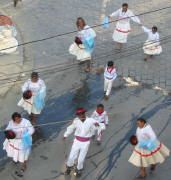 The Saya dance and the music originate from the valley of Yungas (La Paz) and
representative of the Andean Afro culture. The rhythm of Saya is given by the loud sound of drum (bombo) which resounds like the
double palpitation and marked by the tinkling of small bells of the caporal (foreman chosen by the
Spanish settlers to supervise the work of the slaves) who leads the dance while agitating a whip. The men play the drum while
the women sing and dance by stirring up the hips, the shoulders and the arms. The costumes of the dancers are relatively simple:
the women wear a long dress (pollera), a colorful shirt, a shawl (manta), and a borsalino hat, and the men wear shirt, trouser
and sandals.
The Saya dance and the music originate from the valley of Yungas (La Paz) and
representative of the Andean Afro culture. The rhythm of Saya is given by the loud sound of drum (bombo) which resounds like the
double palpitation and marked by the tinkling of small bells of the caporal (foreman chosen by the
Spanish settlers to supervise the work of the slaves) who leads the dance while agitating a whip. The men play the drum while
the women sing and dance by stirring up the hips, the shoulders and the arms. The costumes of the dancers are relatively simple:
the women wear a long dress (pollera), a colorful shirt, a shawl (manta), and a borsalino hat, and the men wear shirt, trouser
and sandals.
Negritos (Tundiqui)
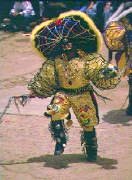
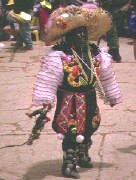 This dance which belongs to the
Saya family is typical of the black community living in the Yungas. It expresses the feelings of the black slaves (this
explains the name "Negritos") who lost their roots when they came during the XVIth century to work like slaves for the
Spaniards in the silver mines of Potosi.
This dance which belongs to the
Saya family is typical of the black community living in the Yungas. It expresses the feelings of the black slaves (this
explains the name "Negritos") who lost their roots when they came during the XVIth century to work like slaves for the
Spaniards in the silver mines of Potosi.
Caporales
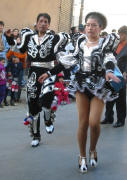 There is often a confusion between Caporales and Saya dances, Caporales is
in fact a derivative of Saya and Tundiqui. One finds in particular the two beat rhythm, the tinkling of bells fixed on the
boots of the dancers, and the whip. The dance reflects the authoritative power of the caporales (foremen at the time of
Spanish colonization). The women wearing short skirts agitate the hips in sensual ways, whereas the men dance with firm and
energetic steps in spectacular choreographic figures. The folk costumes are shining and richly decorated.
There is often a confusion between Caporales and Saya dances, Caporales is
in fact a derivative of Saya and Tundiqui. One finds in particular the two beat rhythm, the tinkling of bells fixed on the
boots of the dancers, and the whip. The dance reflects the authoritative power of the caporales (foremen at the time of
Spanish colonization). The women wearing short skirts agitate the hips in sensual ways, whereas the men dance with firm and
energetic steps in spectacular choreographic figures. The folk costumes are shining and richly decorated.
Suri-sicuris
This dance originates from the Altiplano and existed already before the arrival of the Spaniards in Bolivia. The dancers of Suri-sicuris (Aymara words suri (ostrich) and sikuri (zampoña musician) waer imposing crowns made of ostrich feathers with bright colors in the central part. Their costumes are sober: white starched shirt and white poncho laid out diagonally on their back.
Incas
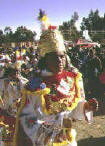
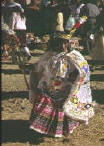 This dance is a theatrical representation
of the Spanish conquest and the immense Tahuantinsuyo Inca empire. The dancers pay homage to the greatness and dignity of the
disappeared civilization, led by the first Inca emperor Manco Capac
and his wife Mama Ocllo nd surrounded by their private guard. The Virgins of the Sun and the
Spanish conquistadors Francisco Pizarro, Diego de Almagro and Valverde priest follow in the procession.
This dance is a theatrical representation
of the Spanish conquest and the immense Tahuantinsuyo Inca empire. The dancers pay homage to the greatness and dignity of the
disappeared civilization, led by the first Inca emperor Manco Capac
and his wife Mama Ocllo nd surrounded by their private guard. The Virgins of the Sun and the
Spanish conquistadors Francisco Pizarro, Diego de Almagro and Valverde priest follow in the procession.
Tinkus
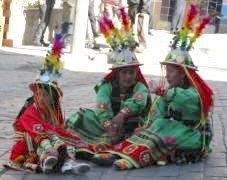 Tinku (meaning "the encounter" in quechua) is a traditional ceremony from the north
of the department of Potosi. The peasants from two close communities clash during one day fighting with their fists and feet.
This bloody tradition (rarely mortal) is perpetrated since the pre-Columbian time to honor Pachamama, Virgin of the Earth.
The participants carry a typical leather helmet (called "montera") and orange or bluish tunics (jaquetas). The Tinku dance puts
in scene two lines of men and women measuring their strength in this ritual combat.
Tinku (meaning "the encounter" in quechua) is a traditional ceremony from the north
of the department of Potosi. The peasants from two close communities clash during one day fighting with their fists and feet.
This bloody tradition (rarely mortal) is perpetrated since the pre-Columbian time to honor Pachamama, Virgin of the Earth.
The participants carry a typical leather helmet (called "montera") and orange or bluish tunics (jaquetas). The Tinku dance puts
in scene two lines of men and women measuring their strength in this ritual combat.
Tobas
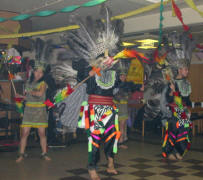 The Tobas dance originates from the time when the Inca empire was accumulating
victorious conquests in the areas of the Bolivian plains and was forcing the indigenous tribes to migrate towards the altiplano.
This dance honors and preserves with pride the ancestral culture and traditions of one of these Amazonian tribes, the Tobas warriors.
The dancers wear Indian tunics made of skin and feathers and are armed with lances, and jump with energetic and light hops.
The Tobas dance originates from the time when the Inca empire was accumulating
victorious conquests in the areas of the Bolivian plains and was forcing the indigenous tribes to migrate towards the altiplano.
This dance honors and preserves with pride the ancestral culture and traditions of one of these Amazonian tribes, the Tobas warriors.
The dancers wear Indian tunics made of skin and feathers and are armed with lances, and jump with energetic and light hops.
Cueca
 The Cueca dance was reserved for the aristocratic class at the time of Spanish
colonization and during the first years of Bolivian independence. The dance is a seduction game between a man and a woman who
dance while agitating a white handkerchief in their right hand. This dance has remained very popular in the whole Bolivia. Some
variations exists according to the regions: Cueca chapaca (Tarija), Cueca paceña (La Paz), Cueca chuquisaqueña (Sucre), Cueca
cochabambina (Cochabamba).
The Cueca dance was reserved for the aristocratic class at the time of Spanish
colonization and during the first years of Bolivian independence. The dance is a seduction game between a man and a woman who
dance while agitating a white handkerchief in their right hand. This dance has remained very popular in the whole Bolivia. Some
variations exists according to the regions: Cueca chapaca (Tarija), Cueca paceña (La Paz), Cueca chuquisaqueña (Sucre), Cueca
cochabambina (Cochabamba).
Kullawada
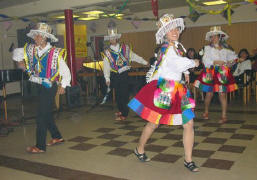 Kullawada is a dance of the altiplano which origins are former to the arrival
of Spaniards in Bolivia. Kullawada is the dance of the spinners and weavers of llama wool. It honors the precious textiles which
were one of the social and economical pillars of the Andean Kollas civilization. The dancers wear elegant costumes, which are
embroidered and decorated with pearls and coins. Men and women wear the same hat (kh'ara) as well as a quenouille (k'apu).
Kullawada is a dance of the altiplano which origins are former to the arrival
of Spaniards in Bolivia. Kullawada is the dance of the spinners and weavers of llama wool. It honors the precious textiles which
were one of the social and economical pillars of the Andean Kollas civilization. The dancers wear elegant costumes, which are
embroidered and decorated with pearls and coins. Men and women wear the same hat (kh'ara) as well as a quenouille (k'apu).
Phujllay (Pujllay)
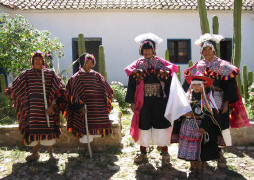 Phujllay is a folk dance from Tarabuco village (near Sucre) celebrating the heroic
courage of the guerrilla soldiers during the independence war against Spaniards. The costumes of the dancers reproduce in a satirical
way the conquistadors' uniform, including the montera (helmet) and of large wooden shoes with spurs.
Phujllay is a folk dance from Tarabuco village (near Sucre) celebrating the heroic
courage of the guerrilla soldiers during the independence war against Spaniards. The costumes of the dancers reproduce in a satirical
way the conquistadors' uniform, including the montera (helmet) and of large wooden shoes with spurs.
Waca-wacas
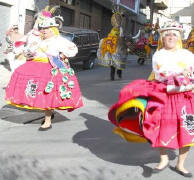
 This dance is a parody of the bullfights which were
very appreciated by the Spanish settlers. The Aymara word waca is a derivative of Spanish vaca (cow).
This dance is a parody of the bullfights which were
very appreciated by the Spanish settlers. The Aymara word waca is a derivative of Spanish vaca (cow).